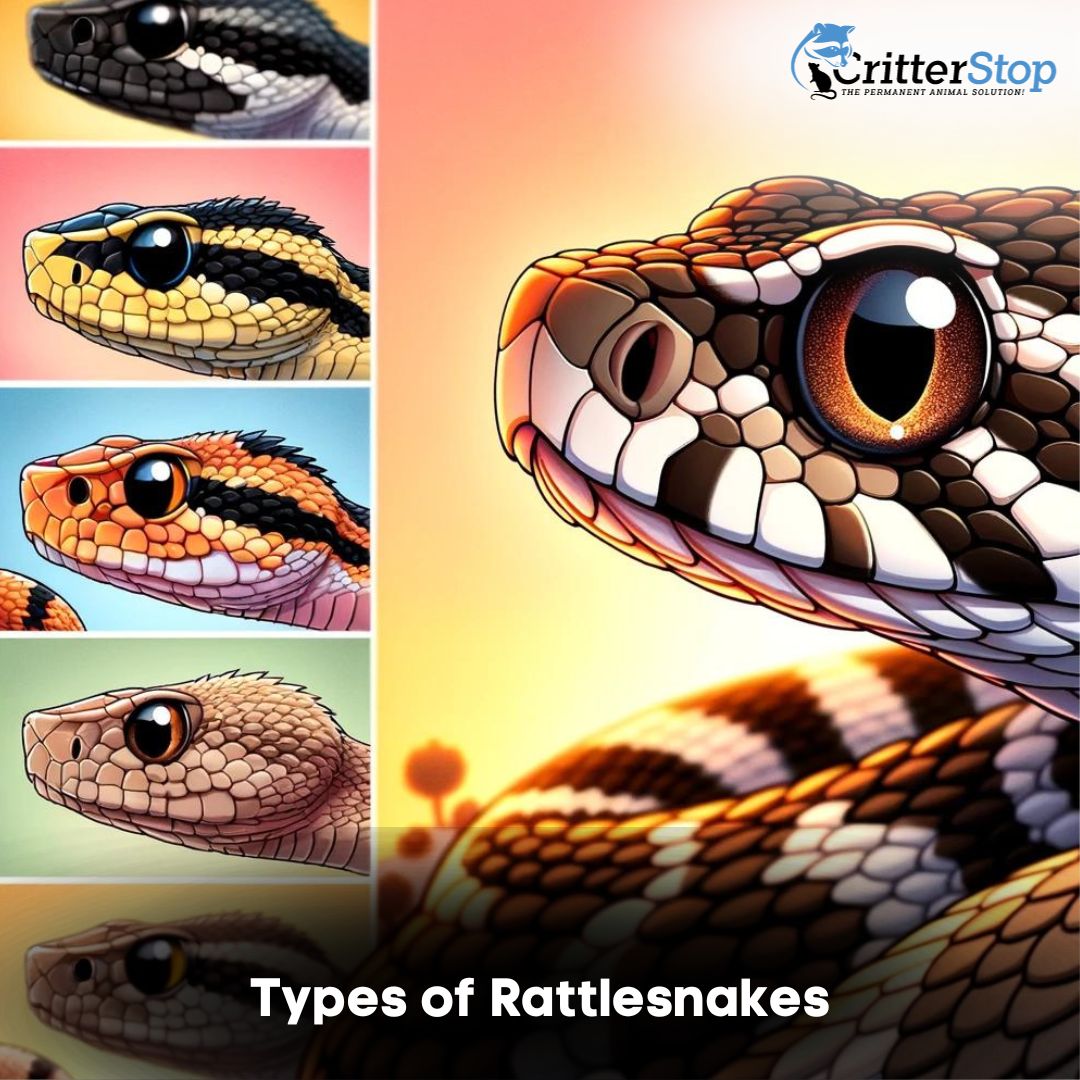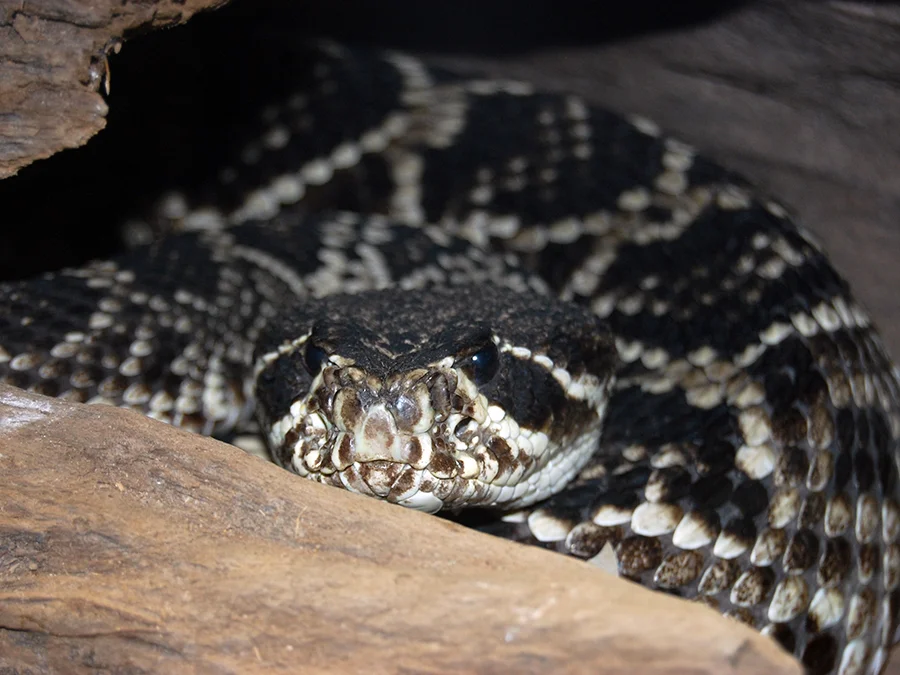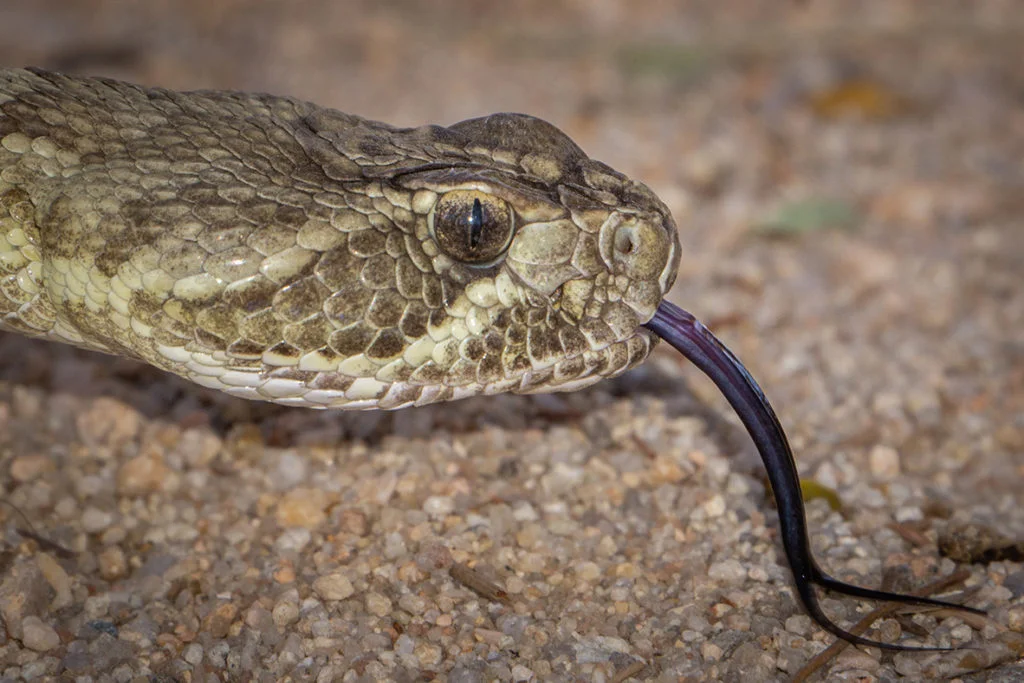
Rattlesnakes, often associated with the wild west and spine-chilling tales, are a captivating subgroup within the viper family. Known for their iconic rattlesnake bites and venomous bites, these serpents have evolved remarkable adaptations to survive and thrive in various ecosystems.
Beyond their fearsome reputation, venomous rattlesnake play crucial roles in ecosystems as apex predators. They help control rodent populations, which can otherwise wreak havoc on crops. Additionally, rattlesnakes have woven themselves into the fabric of human culture, becoming symbols of the American wilderness and sources of folklore. Join Critter Stop in this adventure, where we will explore everything about rattlesnakes, from types of rattlesnakes to the common rattlesnake to species!
The rattlesnake rattler, a distinctive feature of all species of rattlesnakes, is composed of interlocking segments made of keratin, the same material as human nails. It's attached to the snake or rattlesnake's rattle tail and grows as the snake sheds its skin no matter what type of rattlesnake species or any types of rattlesnakes.
Contrary to popular belief, rattlesnakes don't use their rattle as an offensive weapon against people or other animals. Instead, it serves as an ingenious warning system. When only rattlesnake is threatened, a rattlesnake vibrates its rattle, creating a distinctive rattling sound that alerts potential predators and humans to keep their distance.
Meet the Eastern Diamondback Rattlesnake, scientific name Crotalus adamanteus, also known as the heavyweight champion of venomous snakes in North America. These serpents are known for their impressive size, often reaching lengths of 5 to 6 feet and their distinctive diamond-shaped markings that adorn their backs. These diamonds are bordered by a pattern of smaller scales, creating a striking appearance that's unmistakably Eastern Diamondback largest rattlesnake.
These formidable snakes reign over the southeastern United States, carving out a niche in a diverse range of habitats. From the longleaf pine forests of the Carolinas to the swamps of Florida and Alabama, the Eastern Diamondback adapts to its surroundings with surprising ease.

Ambush predators by nature, Eastern Diamondbacks employ a sit-and-wait strategy to catch their prey. They're patient hunters, relying on their cryptic coloration and the element of surprise. Their diet primarily consists of small mammals, such as rodents and rabbits. When the moment strikes, they strike with remarkable speed, injecting venom into their prey through their hollow fangs.
Eastern Diamondbacks possess one of the most potent venomous bites in the snake world, capable of subduing their prey rapidly. Once immobilized, they'll swallow their meal whole, using their flexible jaws and impressive unhinging ability.
These rattlesnakes play a vital role in controlling rodent populations, which can otherwise wreak havoc on local ecosystems and agriculture. While their venom is formidable, these snakes are not quick to strike unless provoked. Given space and respect, they fulfill their essential ecological roles in the southeastern wilds.
The Western Diamondback Rattlesnake shares its name with its more eastern diamondback cousin due to the striking diamond-shaped markings that adorn its back. However, it has its distinct features that set it apart. Typically, Western Diamondbacks have a more prominent and contrasting pattern than their more eastern diamondback relatives. Their colors can range from pale gray to pinkish-brown, with dark diamonds outlined in white or cream. On average, new births can reach up to 8 inch, and the adults can reach lengths of about 30 to 72 inch
These rattlesnakes call the arid landscapes of the southwestern United States and northern Mexico home. You'll find them making their way through the Sonoran and Chihuahuan deserts, thriving in the harsh conditions of these regions.
Western Diamondback Rattlesnakes are unsung heroes of desert ecosystems. They play a pivotal role in controlling rodent populations, which can explode in these arid environments without natural predators. By keeping these populations in check, Western Diamondbacks help maintain the delicate balance of life in the desert.
Much like their eastern counterparts, these rattlesnakes are often misunderstood and misrepresented as threats. However, they serve as valuable members of their ecosystems, contributing to the health and biodiversity of the western United States' unique landscapes.
Timber Rattlesnakes are the masters of camouflage in their forested domains. Their coloring varies, but they often sport a background of muted gray, yellow, or brown, adorned with a series of dark, irregular bands running down their back. These bands sometimes resemble the pattern of tree bark, making them blend seamlessly into their deciduous forest habitats.
These stealthy serpents call the eastern woodlands of North America home. You'll find them hidden among the leaf litter, under fallen logs, or in the dense underbrush. Timber Rattlesnakes are masters of patience, employing an ambush hunting strategy. They remain motionless, relying on their excellent camouflage, until unsuspecting prey ventures too close. Then, in a lightning-quick strike, they deliver their venomous bite to immobilize their quarry.
Timber Rattlesnakes are integral to the health of forest ecosystems. They primarily feed on small mammals like mice and squirrels, helping to control rodent populations. This role as an apex predator is vital in maintaining the balance of forest ecosystems. Without these natural checks and balances, rodent populations can skyrocket, causing damage to vegetation and altering the habitat for other wildlife.
Despite their venomous nature, Timber Rattlesnakes, like many other rattlesnake species, are not inherently aggressive and typically only strike when provoked or threatened. In their forested realm, they are both stealthy predators and vital ecosystem stewards, quietly contributing to the intricate web of life in eastern North American woodlands.
The Mojave Rattlesnake stands out among most rattlesnake species due to its distinctive features, perfectly suited for life in the unforgiving deserts of the American Southwest. One of its most remarkable characteristics is its pale, greenish hue, which helps it blend seamlessly into its arid surroundings. This greenish tint, often accompanied by diamond-shaped patterns along its back, provides excellent camouflage amidst the sandy dunes and desert scrub.
The Mojave Rattlesnake's stomping grounds are the arid deserts of the southwestern United States and northern Mexico. It's a master of survival in these harsh environments, thriving in places where many other creatures would struggle to exist.
Mojave Rattlesnakes are notorious for the potency of their very venomous snakes, which can vary between different subspecies. Some Mojave rattlesnakes possess a neurotoxic venom that can result in severe effects on a bite victim's nervous system. It's essential to exercise caution and respect when around adult rattlesnakes and encountering these venomous snakes while in their native habitats.

Despite their formidable reputation, Mojave Rattlesnakes, like other rattlesnake species, are not naturally aggressive toward humans and will typically only strike when threatened or provoked. In their desert domain, they play a vital role in controlling rodent populations and are an integral part of the intricate web of life in some of the world's harshest landscapes.
The sidewinder rattlesnake earns its name with a truly extraordinary method of locomotion. Rather than moving in the conventional serpentine fashion, sidewinders employ a mesmerizing sidewinding technique. This involves lifting their body off the hot desert sand and moving it forward in a series of lateral loops. This specialized form of locomotion allows them to traverse the scorching sands efficiently while minimizing contact with the blistering surface.
Physically, sidewinders possess adaptations that complement their unique locomotion. They tend to have a pale, light-colored background with dark, irregular crossbands that blend well with the desert environment.
Surviving in extreme desert conditions demands remarkable adaptations, and sidewinders are well-equipped. Their scales have evolved to resist the intense heat of the desert sand, helping to prevent burns as they traverse scorching surfaces. Additionally, their lateral movements help them move swiftly and efficiently across the shifting dunes and hot sands.
Sidewinders primarily feast on small rodents, such as mice and lizards, which are plentiful in desert ecosystems. To secure their meals, sidewinders rely on ambush tactics and incredible strike accuracy. They patiently await their prey's approach, then launch a lightning-fast strike to inject their venom, quickly incapacitating their quarry.
Sidewinders exemplify the art of adaptation, thriving in one of the harshest environments on Earth. Their unique locomotion, desert-ready adaptations, and precision hunting techniques make them a fascinating and integral part of desert ecosystems.
Prairie Rattlesnakes are easily recognizable due to their distinctive features. Their most iconic characteristic is, of course, their buzzing rattle, which they employ as a warning signal. Additionally, they often boast a series of facial stripes running down each side of their face, creating a striking pattern.
These types of rattlesnakes are closely tied to the grasslands and prairies of North America, where they've become adept at navigating this expansive and open terrain. Prairie Rattlesnakes often make use of burrows, whether dug by themselves or other animals, for shelter and protection from temperature extremes.
Their behavior is a testament to their adaptability. Prairie Rattlesnakes are typically not aggressive and will usually seek to avoid confrontation with larger animals, including humans. When encountered, they'd rather issue a warning through their rattle than resort to a bite.
Within the vast grasslands they call home, Prairie Rattlesnakes form complex interactions with a variety of species. They play an essential role in controlling rodent populations, which are abundant in these habitats. By keeping these populations in check, they indirectly contribute to the preservation of vegetation and the maintenance of a balanced ecosystem.
Their presence also shapes the behavior of other various prairie rattlesnake species. Mammals and birds that share the great basin prairie rattlesnake in their habitat have evolved strategies to avoid encounters with these rattlesnakes, further illustrating the interconnectedness of species in these grassland ecosystems.
Prairie Rattlesnakes may be misunderstood, but they are integral components of the prairie ecosystems they inhabit, playing a crucial role in maintaining the delicate balance of life on the open plains of North America.
Don't let their diminutive size fool you; Pygmy Rattlesnakes are a unique and fascinating rattlesnake species. These snakes typically measure less than two feet in length, making them among the smallest of the rattlesnakes. Their small size is just one of their many adaptations to their chosen habitat. It easily recognized them due to their small size and dusky black spots around their bodies.

Pygmy Rattlesnakes are most at home in the wetland habitats of the southeastern and eastern United States only. These humid environments provide them with ample opportunities to hunt their preferred prey and find suitable shelter.
These rattlesnakes primarily feed on amphibians and small reptiles, showcasing their diverse diet. To hunt their prey, they employ cryptic coloration, blending seamlessly into their surroundings. Like their larger relatives, Pygmy Rattlesnakes are ambush predators, relying on patience and precision to secure their meals.
The Massasauga rattlesnake, tiger rattlesnake and Eastern Massasauga rattlesnakes share similarities, but they exhibit distinct range differences. Eastern Massasaugas are generally found further east, while Massasaugas have a broader distribution in North America.
These rattlesnakes are often associated with wetlands and grasslands, where they play vital roles in maintaining ecosystem health. They help control populations of small mammals, frogs, and insects, contributing to the delicate balance of these unique habitats.
Both the Massasauga rattlesnake and Eastern Massasauga rattlesnakes face conservation challenges due to habitat loss and fragmentation. Their populations are closely monitored, and conservation efforts are in place to ensure their survival. These snakes serve as indicators of wetland and grassland ecosystem health, making their protection crucial for the well-being of these environments.
Meet the Red Diamond Rattlesnake, a remarkable species distinguished by its striking appearance. Their most defining feature is the vivid red diamond-shaped markings that adorn their scales, set against a backdrop of vibrant yellow. These unique patterns make them stand out in the world of other types of rattlesnakes, everywhere.
The Red Diamond Rattlesnake has made California its primary residence. Within this diverse state, they exhibit adaptability to a wide range of environments. They often choose to inhabit a mix of desert and woodland landscapes, showcasing their ability to thrive in contrasting ecosystems.
These rattlesnakes play a vital role in maintaining the ecological balance of California's diverse landscapes. One of their essential contributions is controlling rodent populations. Rodents, such as mice and rats, can multiply rapidly and have adverse effects on vegetation and the overall health of ecosystems. Red Diamond Rattlesnakes, by preying on these rodents, help keep their numbers in check, preserving the delicate equilibrium of California's ecosystems.
As the guardians of biodiversity in the Golden State, Red Diamond Rattlesnakes remind us of the intricate web of life that depends on each species, no matter how misunderstood or fearsome they may seem.
For centuries, rattlesnakes have woven themselves into the tapestry of human culture, symbolizing a unique blend of strength, resilience, and adaptability. These qualities have earned rattlesnakes a special place in various human societies and a profound cultural significance that transcends their role in the natural world.
In Native American cultures, rattlesnakes are often revered as powerful symbols, embodying qualities such as transformation, protection, and healing. The rattlesnake's ability to shed its skin represents rebirth and renewal, while its rattling warning serves as a reminder of vigilance in the face of danger.
Beyond Native American traditions, rattlesnakes have appeared in art, folklore, and even on flags. Their distinctive rattling sound has been likened to a musical instrument, and their image has adorned everything from pottery to tattoos.
Myths and misconceptions have often clouded the understanding of rattlesnake and snake bites themselves. In this section, we will debunk common rattlesnake myths and provide clear, accurate information about the risks associated with rattlesnake bites and encounters.
First and foremost, it's crucial to understand that rattlesnakes do not actively seek out humans to attack them. They are generally reclusive and prefer to avoid confrontation. When tiger rattlesnake is confronted, their first line of defense is issuing a warning through their distinctive rattle, rather than immediately resorting to biting.
Rattlesnake venomous snake bites are, while serious, are rarely fatal when treated promptly and appropriately. Immediate medical attention is essential in the event of a rattlesnake bite. Anti-venom treatments are available and highly effective in countering the effects of rattlesnake venom.
Understanding rattlesnakes' roles in ecosystems and their benefits to humans fosters coexistence and supports conservation efforts. At Critter Stop we believe that these reptiles are not to be feared but respected and admired for their contributions to the natural world.
Rattlesnakes serve as vital components of ecosystems by helping control rodent populations, which, if left unchecked, can have adverse effects on agriculture and human health. Their presence reminds us of the interconnectedness of species and the delicate balance of nature.
By promoting awareness and dispelling myths newborn rattlesnakes, we can cultivate a greater understanding of rattlesnakes and ensure that these remarkable reptiles continue to thrive in their natural habitats. Respecting their space and appreciating their significance in ecosystems is the key to harmonious coexistence between humans and rattlesnakes.
Rattlesnakes, like many other species, face a set of challenges that put their populations at risk. Habitat loss due to urban development and agriculture is a significant concern. As human populations expand, rattlesnakes often lose their natural habitats, forcing them into closer proximity to human activities.
Additionally, over-hunting and illegal collection other rattlesnakes for the pet trade pose serious threats to the timber rattlesnake populations. Some individuals seek these reptiles as exotic pets, further impacting wild timber rattlesnake populations.
Road mortality is another significant issue. Rattlesnakes, like many other wildlife species, are vulnerable to being struck by vehicles as they attempt to cross roads.
Conservationists are dedicated to safeguarding rattlesnakes and their habitats. Several rattlesnake species have received protection status in various regions, making it illegal to harm or collect them without proper permits. These protected areas and regulations help create safe havens for these unique reptiles.
Efforts to mitigate habitat loss include the establishment of conservation easements and protected lands where rattlesnakes can thrive undisturbed. By preserving their natural habitats, conservationists ensure that rattlesnakes continue to play their essential roles in ecosystems.
Individuals can contribute to rattlesnake conservation in several ways. Supporting conservation organizations that work towards rattlesnake protection and habitat preservation is crucial. Advocating for responsible behavior in rattlesnake habitats, such as refraining from harming or collecting them, helps reduce human impact.
Spreading awareness about the importance of these reptiles in ecosystems and dispelling myths related to common rattlesnake' encounters is equally essential. Education and understanding are key to fostering respect and coexistence between humans and rattlesnakes.
Rattlesnakes possess remarkable heat-sensing pits located between their eyes and nostrils, which enable them to detect the body heat of their prey with remarkable accuracy, even in complete darkness. Their strike is one of the fastest movements in the animal kingdom, allowing them to immobilize their prey swiftly.
In indigenous cultures,venomous snakes have symbolized strength, transformation, and protection for generations. Their iconic rattling sound has been likened to a musical instrument, making them not just biological wonders but cultural icons, reminding us of the enduring connection between humans and the natural world.
In our journey through the world of rattlesnakes and genus crotalus, we've encountered a remarkable diversity of snake species throughout, each with its own unique adaptations that allow it to thrive in specific ecosystems. From the vivid patterns of Red Diamond Rattlesnakes to the cryptic coloration of Timber Rattlesnakes, these reptiles are true marvels of nature's design.
As we conclude our exploration of how rattlesnakes live, it's crucial to strike a balance between fear and fascination. While rattlesnakes may evoke awe and caution, they also play essential roles in ecosystems by controlling rodent populations and contributing to biodiversity. Respecting their space and understanding their significance is key to fostering a harmonious coexistence with these reptiles.
Visit our Critter Library and learn more about our furry friends